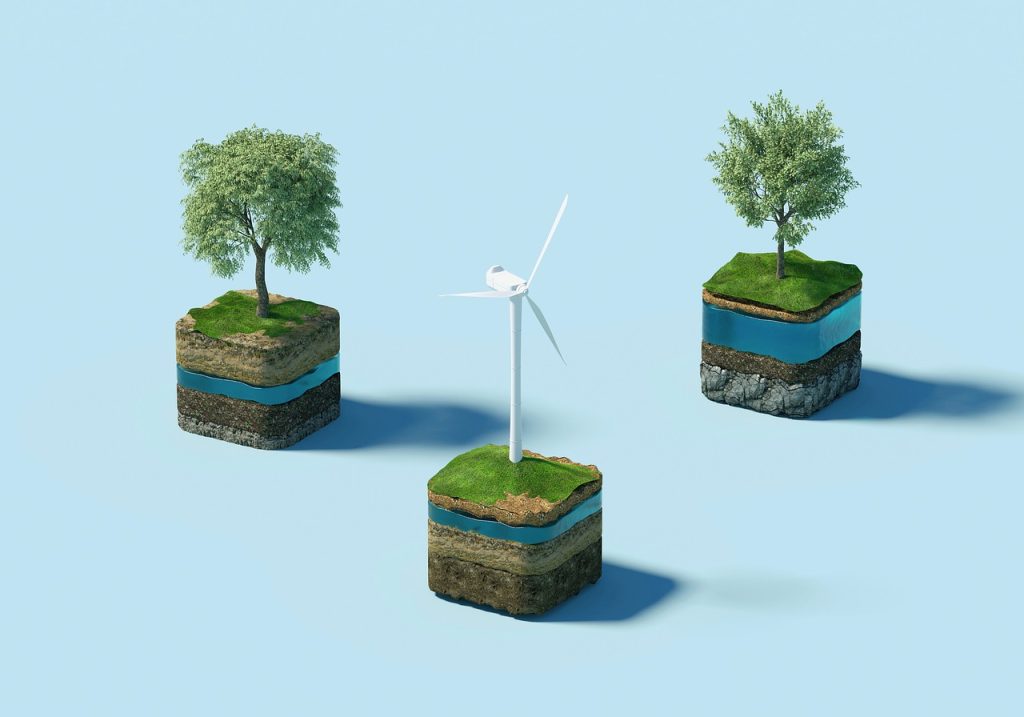Imagine a world where we can achieve our desired quality of life without harming our planet. A world where we can continue to enjoy the comforts and conveniences we’ve become accustomed to, while also reducing our ecological footprint. Lower land and resource consumption is the key to making this dream a reality. By finding innovative ways to use our land and resources more efficiently, we can not only protect our environment but also ensure a sustainable future for generations to come. In this article, we will explore the importance of reducing land and resource consumption and delve into some practical strategies that can help us achieve this goal.

The Importance of Lowering Land and Resource Consumption
Lowering land and resource consumption is critical for ensuring the sustainability of our planet. As the global population continues to grow, the demand for land and resources also increases, putting significant strain on the environment. By reducing our consumption, we can minimize the negative impacts on ecosystems, conserve natural resources, and mitigate the effects of climate change.
Understanding the Impact of Land and Resource Consumption
Land and resource consumption refers to the utilization and exploitation of natural resources, including land, water, minerals, and energy, to meet human needs. This consumption has a profound impact on the environment, leading to deforestation, habitat destruction, depletion of natural resources, pollution, and greenhouse gas emissions.
The alarming rate of deforestation, for example, contributes to the loss of biodiversity, disrupts ecosystems, and releases large amounts of carbon dioxide into the atmosphere. Unsustainable extraction of minerals and energy resources depletes these valuable assets, causing irreversible damage to the environment.
Benefits of Lowering Land and Resource Consumption
Lowering land and resource consumption offers a multitude of benefits. First and foremost, it helps to preserve the natural environment and protect biodiversity. By reducing deforestation and habitat destruction, we can safeguard valuable ecosystems and the species that rely on them.
Additionally, lowering consumption can help to mitigate climate change. Many of the activities associated with land and resource consumption, such as deforestation and fossil fuel extraction, release significant amounts of greenhouse gases. By reducing these activities, we can decrease our carbon footprint and contribute to the fight against climate change.
Lowering land and resource consumption also promotes sustainable development. By using resources more efficiently, we can ensure their availability for future generations. This shift towards sustainability can also drive innovation and create economic opportunities, such as the development of renewable energy technologies and sustainable agricultural practices.
Challenges of Lowering Land and Resource Consumption
While the benefits of lowering land and resource consumption are clear, there are several challenges that need to be addressed. One of the main challenges is changing ingrained patterns of behavior. Many of our consumption habits are deeply rooted and changing them requires a significant shift in mindset and lifestyle.
Another challenge is the resistance from industries and businesses that rely on resource-intensive practices. These entities may resist changes that could potentially impact their profitability or require significant investments in sustainable alternatives.
Additionally, limited awareness and engagement of the public can hinder progress in lowering consumption. Without proper education and awareness initiatives, individuals may not fully understand the importance of their actions in mitigating the environmental impacts of their consumption.
Strategies for Lowering Land Consumption
Lowering land consumption is crucial for preserving natural habitats, reducing deforestation, and creating more sustainable urban environments. Several strategies can be implemented to achieve this goal.
Promoting Sustainable Urban Development
One effective strategy for lowering land consumption is promoting sustainable urban development. This involves designing cities and communities in a way that maximizes land use efficiency. By encouraging compact, mixed-use development, we can minimize the need for sprawling suburban areas and preserve valuable land for conservation.
Sustainable urban development also emphasizes the importance of green spaces, such as parks and urban forests, which provide multiple environmental, social, and health benefits. These green areas not only enhance biodiversity but also promote physical activity, improve air quality, and reduce the urban heat island effect.
Implementing Smart Land Use Policies
Smart land use policies play a crucial role in lowering land consumption. Governments and local authorities can implement zoning regulations and land use planning that prioritize compact development and discourage urban sprawl.
Incentives can also be provided for developers and individuals who choose to build or reside in high-density, mixed-use buildings. By ensuring that new developments are located near existing infrastructure and services, we can reduce the need for new land clearance.
Encouraging Compact City Design
Compact city design is another effective strategy for lowering land consumption. By designing cities with a focus on pedestrian-friendly neighborhoods, efficient public transportation systems, and a mix of residential, commercial, and recreational areas, we can minimize the need for excessive land use.
Compact city design also promotes walkability and cycling, reducing the reliance on cars and mitigating traffic congestion. This, in turn, improves air quality and decreases carbon emissions from transportation.
Strategies for Lowering Resource Consumption
In addition to lowering land consumption, it is equally important to reduce resource consumption to ensure a sustainable future. Several strategies can be employed to achieve this.
Promoting Circular Economy
Promoting a circular economy is a key strategy for lowering resource consumption. A circular economy aims to minimize waste and maximize resource efficiency by keeping materials in use for as long as possible. Instead of the traditional linear model of extraction, production, consumption, and disposal, the circular economy seeks to close the loop by recycling and reusing materials.
Through the implementation of sustainable production processes, efficient waste management systems, and innovative recycling technologies, we can reduce the demand for raw materials and decrease the environmental impact of resource extraction.
Implementing Sustainable Resource Management
Effective resource management is crucial for lowering consumption. This involves utilizing resources more efficiently throughout their life cycle, from extraction to disposal. By implementing sustainable resource management practices, such as reducing waste, optimizing production processes, and adopting eco-friendly technologies, we can minimize resource extraction and waste generation.
Encouraging Sustainable Consumption and Production
Encouraging sustainable consumption and production is essential for reducing resource consumption. This involves promoting responsible and conscious consumer behavior, emphasizing the importance of choosing eco-friendly products and services.
Governments can play a significant role in incentivizing sustainable production practices, such as providing tax incentives for businesses that adopt eco-friendly manufacturing processes or introducing labeling schemes that inform consumers about the environmental impact of products.
The Role of Technology in Lowering Land and Resource Consumption
Technology plays a crucial role in lowering land and resource consumption. Continued advancements in various fields hold the key to developing more sustainable practices.
Advancements in Sustainable Agriculture
Sustainable agriculture technologies offer the potential to lower land consumption while still meeting global food demands. Techniques such as precision farming, hydroponics, and vertical farming allow for higher crop yields with less land and water usage.
Using predictive analytics and remote sensing technologies, farmers can optimize the use of resources, minimize waste, and increase productivity. Furthermore, genetic engineering and biotechnology can contribute to the development of crops with improved yield and resilience to environmental challenges.
Smart Energy Management Systems
Smart energy management systems enable efficient use of energy resources, reducing both land and resource consumption. By implementing smart grids, buildings, and appliances, we can optimize electricity consumption, minimize energy wastage, and integrate renewable energy sources effectively.
These systems utilize advanced sensors, automation, and real-time data analytics to monitor and control energy usage, ensuring maximum efficiency. By optimizing energy consumption, we can reduce the need for new energy infrastructure and the associated land requirements.
Waste Reduction and Recycling Technologies
Innovative waste reduction and recycling technologies play a significant role in lowering land and resource consumption. By implementing advanced waste management systems, we can minimize the amount of waste generated and divert it from landfills.
Technologies such as anaerobic digestion, composting, and mechanical biological treatment enable the conversion of organic waste into valuable resources, such as biogas and compost. Additionally, improved recycling technologies allow for the recovery of materials from waste streams, reducing the need for virgin resources.

The Role of Policies and Regulations in Lowering Land and Resource Consumption
Policies and regulations play a critical role in reducing land and resource consumption. Governments and international bodies can implement various measures to incentivize sustainable practices and ensure compliance.
Environmental Impact Assessments
Environmental impact assessments (EIAs) are crucial tools for evaluating the potential environmental effects of development projects. By conducting thorough assessments, governments can identify and mitigate the negative impacts of land and resource consumption.
EIAs help to inform decision-making by considering factors such as biodiversity loss, habitat destruction, and carbon emissions. By requiring developers to adhere to the findings and recommendations of EIAs, governments can ensure that development projects are carried out in an environmentally responsible manner.
Land Use Planning Regulations
Land use planning regulations are essential for guiding development in a sustainable manner. Governments can establish zoning laws, urban growth boundaries, and greenbelt areas to prevent excessive land consumption and promote efficient land use.
By carefully controlling where and how development takes place, governments can ensure that land is used in the most environmentally and socially beneficial way. Moreover, land use planning regulations can prioritize the protection of ecologically sensitive areas and encourage the preservation of green spaces.
Resource Efficiency Standards
Resource efficiency standards can be implemented to lower resource consumption and promote sustainable practices. Governments can set mandatory standards for energy efficiency, water usage, waste generation, and recycling rates for industries and businesses.
By enforcing these standards, governments can encourage the adoption of resource-efficient technologies and practices, reducing the environmental impact of production processes. Furthermore, these standards can drive innovation and create economic opportunities for industries that develop and implement green technologies.
The Role of Businesses and Industries in Lowering Land and Resource Consumption
Businesses and industries have a significant responsibility in lowering land and resource consumption. By adopting sustainable practices, they can contribute to environmental conservation and enhance their long-term viability.
Adopting Sustainable Supply Chain Practices
Adopting sustainable supply chain practices is crucial for reducing land and resource consumption. Businesses can evaluate their supply chains to identify inefficiencies and areas for improvement, such as excessive transportation, wastage, and overuse of resources.
By collaborating with suppliers, implementing sustainable sourcing practices, and prioritizing local and renewable resources, businesses can minimize the environmental impact of their operations. Additionally, businesses can prioritize circular economy principles by designing products with recyclability and durability in mind.
Implementing Eco-design Principles
Eco-design principles involve considering the environmental impact of a product throughout its life cycle. By implementing eco-design principles, businesses can minimize resource consumption and waste generation from the initial design stages.
This approach involves using sustainable materials, optimizing product performance and lifespan, and designing for ease of repair and recycling. By prioritizing eco-design, businesses can reduce the need for new resources, lower waste generation, and contribute to the circular economy.
Promoting Resource Efficiency
Promoting resource efficiency is essential for businesses and industries to lower land and resource consumption. By optimizing production processes, reducing waste, and implementing energy-saving measures, businesses can minimize their environmental footprint.
Investing in energy-efficient technologies, recycling initiatives, and waste reduction strategies can significantly reduce resource consumption. Additionally, businesses can explore alternative sources of energy, such as renewable energy systems, to further minimize their reliance on finite resources.

The Role of Education and Awareness in Lowering Land and Resource Consumption
Education and awareness play a crucial role in promoting sustainable behaviors and lowering land and resource consumption. By educating individuals and raising awareness about the importance of conservation, we can drive meaningful change.
Educating the Public about Sustainable Living
Educating the public about sustainable living is essential for encouraging responsible consumption and reducing land and resource consumption. Schools, community organizations, and government initiatives can offer educational programs that inform individuals about the environmental impacts of their choices.
By teaching concepts such as carbon footprints, resource conservation, and sustainable lifestyle choices, individuals can make more informed decisions and actively contribute to lowering consumption. Public campaigns and awareness initiatives can also play a crucial role in reaching a wider audience and promoting behavior change.
Promoting Environmental Responsibility in Schools
Schools play a critical role in shaping the attitudes and behaviors of future generations. By integrating environmental responsibility into the curriculum, schools can instill a sense of stewardship and mindfulness towards the environment.
Environmental education can include lessons on biodiversity, climate change, sustainable practices, and the importance of reducing land and resource consumption. Additionally, schools can implement sustainable practices, such as waste recycling programs, energy-saving initiatives, and green spaces, to provide practical examples for students.
Encouraging Sustainable Consumption Behaviors
Encouraging sustainable consumption behaviors is essential for lowering land and resource consumption. Individuals can be encouraged to make conscious choices, such as choosing locally sourced and organic products, reducing waste, and practicing energy conservation.
Governments can provide incentives for sustainable choices, such as tax deductions for energy-efficient appliances or subsidies for public transportation. Additionally, businesses can play a role by providing eco-friendly options and transparent information about the environmental impact of their products.
The Role of International Collaboration in Lowering Land and Resource Consumption
International collaboration is crucial for addressing the global challenges associated with land and resource consumption. By sharing best practices, collaborating on research and development, and joining efforts for environmental conservation, countries can work together to achieve a more sustainable future.
Sharing Best Practices and Knowledge
Sharing best practices and knowledge across borders is essential for fostering innovation and driving progress in lowering land and resource consumption. Countries can learn from one another’s successes and challenges, adopting and adapting sustainable strategies that have proven effective elsewhere.
International conferences, workshops, and forums can provide platforms for policymakers, researchers, and practitioners to exchange ideas and share experiences. Additionally, international organizations and networks can facilitate the dissemination of knowledge and best practices on a global scale.
Collaborative Research and Development
Collaborative research and development efforts can accelerate the development and implementation of sustainable solutions. By pooling resources and expertise, countries can collaborate on projects aimed at improving resource efficiency, developing renewable energy technologies, and minimizing land consumption.
International research collaborations can lead to breakthroughs in sustainable agriculture, renewable energy production, waste management systems, and other areas critical to lowering consumption. By working together, countries can leverage their collective knowledge and resources to address global challenges more effectively.
Joint Efforts for Environmental Conservation
Land and resource consumption is a global issue that requires joint efforts for effective conservation. International agreements and initiatives, such as the Paris Agreement and the Sustainable Development Goals, provide frameworks for countries to collaborate and tackle these challenges together.
By setting shared goals and targets, countries can align their efforts towards sustainable practices and resource conservation. Collaboration can take the form of joint conservation projects, information sharing, and coordinated policies that prioritize environmentally responsible practices.
Case Studies: Successful Examples of Lowering Land and Resource Consumption
Examining successful case studies can provide valuable insights into effective strategies for lowering land and resource consumption.
Curitiba, Brazil: A Model for Sustainable Urban Planning
Curitiba, Brazil, is widely recognized as a model for sustainable urban planning. The city has implemented various strategies to lower land consumption and promote efficient land use. The integrated transport system, including bus rapid transit and pedestrian zones, has reduced the reliance on cars and minimized traffic congestion.
Curitiba has also prioritized green spaces and implemented an extensive network of parks and urban forests. These green areas not only preserve biodiversity but also provide recreational spaces for residents and help with flood control. The city’s commitment to sustainable urban development has resulted in a vibrant, livable, and environmentally conscious city.
Sweden’s Circular Economy Approach
Sweden has emerged as a leader in implementing a circular economy approach. The country has developed comprehensive waste management systems that prioritize recycling and energy recovery. By effectively separating and sorting waste, Sweden has achieved impressive recycling rates, reducing the need for new resource extraction.
Moreover, Sweden has embraced innovative technologies, such as waste-to-energy plants, which convert waste into heat and electricity. This approach significantly reduces the reliance on fossil fuels and minimizes the environmental impact of waste disposal.
Toyota: Leading the Way in Sustainable Manufacturing
Toyota, a leading automotive manufacturer, has prioritized sustainable manufacturing practices to lower land and resource consumption. The company has implemented eco-friendly production processes that minimize waste generation, optimize resource usage, and reduce energy consumption.
Toyota has also embraced the concept of eco-design, developing vehicles with improved fuel efficiency and recyclability. The company’s commitment to sustainability extends to its supply chain, where it actively promotes responsible sourcing practices and collaborates with suppliers to reduce overall environmental impact.
Overcoming Barriers to Lowering Land and Resource Consumption
Several barriers need to be overcome to effectively lower land and resource consumption.
Lack of Political Will and Policy Implementation
One of the main barriers is the lack of political will and policy implementation. Governments and policymakers must prioritize sustainability and create an enabling environment for sustainable practices. This involves developing and enforcing regulations, providing incentives, and committing to long-term plans for resource conservation.
To address this barrier, there is a need for increased awareness and advocacy to put pressure on policymakers, demonstrating the urgency and importance of taking action to lower consumption. Collaboration between governments, civil society organizations, and businesses can help drive the necessary policy changes.
Resistance from Industries and Businesses
Resistance from industries and businesses can pose a significant barrier to lowering land and resource consumption. Some sectors may resist changes that could impact their profitability or require substantial investments in sustainable alternatives.
To overcome this barrier, governments can provide incentives and support for businesses to transition towards sustainable practices. This can include grants, tax incentives, and assistance in accessing new markets or technologies. Collaboration between businesses and sustainability experts can also help identify and address the specific challenges faced by various sectors.
Limited Awareness and Engagement of the Public
Limited awareness and engagement of the public can hinder progress in lowering consumption. Many individuals may not fully understand the environmental impacts of their consumption choices or may feel overwhelmed by the scale of the issue.
To address this barrier, education and awareness initiatives must be prioritized. Promoting sustainable behaviors and providing accessible information can empower individuals to make informed choices and actively contribute to reducing land and resource consumption. Governments, non-profit organizations, and the private sector can collaborate on public campaigns and educational programs to raise awareness and promote behavior change.
In conclusion, lowering land and resource consumption is of paramount importance for the sustainability of our planet. By implementing strategies such as promoting sustainable urban development, adopting circular economy principles, leveraging technology, enacting supportive policies, engaging businesses and industries, fostering education and awareness, and encouraging international collaboration, we can work towards a more sustainable future. While there may be challenges and barriers to overcome, the benefits of lowering consumption, including environmental conservation, climate change mitigation, and economic opportunities, make the pursuit of sustainable practices essential for the well-being of current and future generations.










